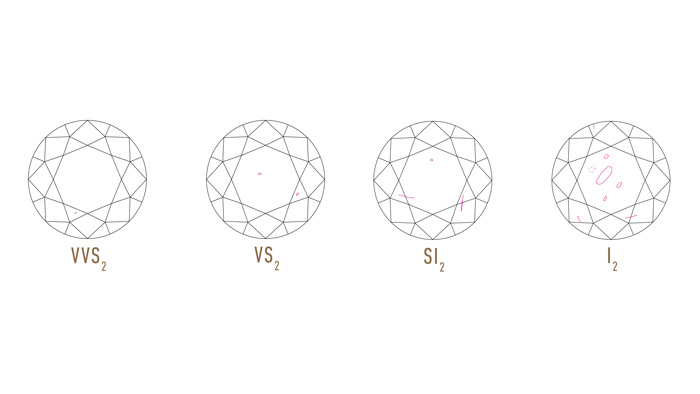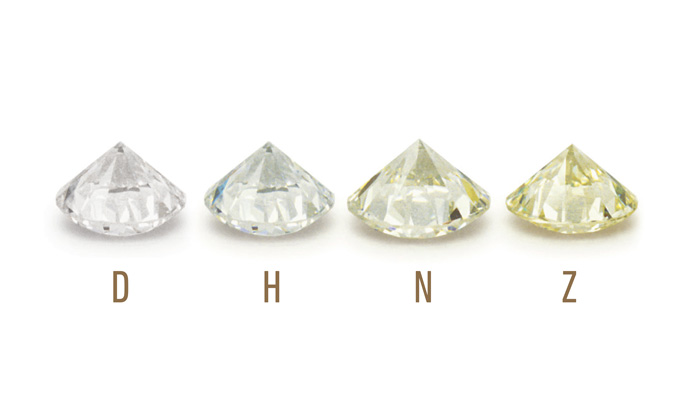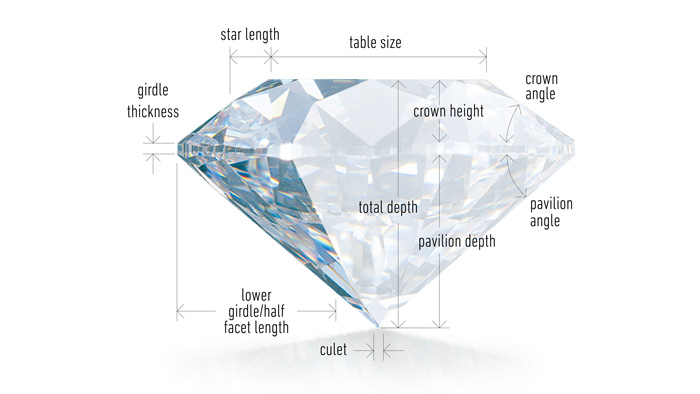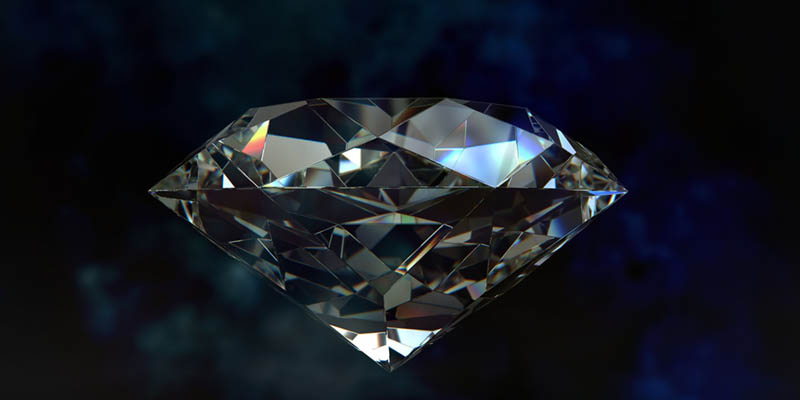Purchasing diamond jewelry can be a major emotional and financial investment. It’s important to understand how to tell diamond quality. Those in the jewelry and antiques business refer to the 4 Cs of diamonds: cut, clarity, color, and carat. The diamond quality scale depends on these four factors, and when you’re thinking about buying a special ring, necklace, cufflinks, or set of earrings, you should understand what they mean.
The 4 Cs of Diamonds are Carat, Clarity, Color, and Cut of diamonds.
Carat
Diamond Carat measures the weight of a diamond. A metric carat is defined as 200 milligrams.
A carat is divided into 100 points, which allows measurement to be more precise to the 100th decimal point.
Did you know that there is a term in the industry called “magic sizes”. This refers to diamonds that are just under 1.0, 1.5, 2.0 carats and so on. Market prices raise at these carat markers, because everybody wants that one carat or two carat diamond. If you were to buy a .98 carat diamond, for example, you are getting the relatively same face size of diamond, but paying less (of similar quality).
Carat is abbreviated CT or Ct. for a single diamond. If you see CTW, that is the abbreviation for Carat Total Weight (some places will also use CTTW). This refers to the total diamond carat weight for the piece of jewelry.
Clarity
Diamond Clarity refers to the absence of inclusions and blemishes. Internal characteristics are referred to as inclusions and external characteristics are blemishes. Most of the clarity characteristics you will see are inclusions within the stone. Clarity ranges from the ultrarare Flawless down to I3.
Evaluating diamond clarity involves determining the number, size, relief, nature, and position of these characteristics, as well as how these affect the overall appearance of the stone. While no diamond is perfectly pure, the closer it comes, the higher its value.

The GIA Diamond Clarity Scale has 6 categories, some of which are divided, for a total of 11 specific grades.
Flawless (FL)
No inclusions and no blemishes are visible to a trained eye under 10x magnification.
Internally Flawless (IF)
No inclusions visible under 10x magnification.
Very, Very Slightly Included (VVS1 and VVS2)
Inclusions so slight they are difficult for a skilled eye to see under 10x magnification.
Very Slightly Included (VS1 and VS2)
Inclusions are observed with effort under 10x magnification, but can be characterized as minor.
Slightly Included (SI1 and SI2)
Inclusions are noticeable under 10x magnification.
Included (I1, I2, and I3)
Inclusions are obvious under 10x magnification, which may affect transparency and brilliance.
Many inclusions and blemishes are too tiny to be seen by anyone other than a trained diamond grader. To the naked eye, a VS1 and an SI2 diamond may look exactly the same, but these diamonds are quite different in terms of overall quality and value.
You tend to see better diamond clarity used for rings, as opposed to necklaces or earrings, since you view them from a closer perspective on a regular basis.
Color
Diamond Color actually refers to the absence of color in the majority of diamonds on the market. GIA’s color grading scale is ranked D-Z with colorless being D and Z having the most color, before getting to the Fancy Colored Diamonds (which we will look at down below).
When evaluating diamond color, trained professionals will compare the diamond to master stones that have established color values. This is all done under controlled lighting. An untrained eye may not see color distinctions, but these differences greatly influence the value of the diamond.
Why does the GIA color grading system start at D? Before GIA created the universal D-Z Color Grading Scale, a variety of other systems were used loosely, which included A, B & C. The creators of the GIA Color Scale wanted to start fresh, without any association with earlier systems. Thus the GIA scale starts at the letter D.

D Color is perfectly pure, simply colorless. E color is close behind, followed by F, which are both still in the colorless range.
G, H, I and J are all considered Near Colorless. Some consumers may start to see color in the G-H range, but most will not see the barely there yellow tint until the I-J range.
K, L and M are in the Faint color range. The yellow tint in the diamond is more noticeable in this range. In the case below, the color is played up even more by the chosen setting.
N-R is considered the Very Light range. In this range the diamonds may begin to appear yellow in color, but they are still in the middle of the scale with much more hue to come.
S-Z are considered the Light Yellow range, but we are still not into the Fancy color range yet. These diamonds are a good choice, especially for accent stones, or for those wanting color without wanting to have to pay the higher prices of the Fancy color stones.
Beyond Z are the Fancy Colored Diamonds. These may be yellow, orange, brown, blue, pink, etc. or any number of combinations to accurately describe the color. The three Fancy Colored diamonds in the ring below are all slightly different colors and are described as such in their Fancy Color designations.
Fancy colored diamonds are quite rare, but some more than others. For example, yellow and brown diamonds are more prevalent than the more exclusive pink, green and blue.
Fancy Colored Diamonds also vary in their intensity, which also affects price, such as Fancy Light, Fancy Vivid and Fancy Deep.
The other consideration for Fancy Colored diamonds is how the color was obtained. Natural is obviously the most desirable, but also the most expensive. You will also find treated, enhanced and irradiated colored diamonds, which allow the average consumer to enjoy them as well.
Cut
When we are talking about the cut of diamonds, we are not talking about the shape, i.e. marquise, heart, trillion, etc. We are actually referring to the proportions of the diamond.

How the diamond is cut, the proportions, symmetry and polish, determine the light return, brightness and scintillation (sparkle) of a diamond. Here at Solvang Antiques, we also work with older cuts of diamonds. The difference in these diamonds will be discussed below.
When evaluating diamond cut, the diamond that has an even pattern of bright and dark areas, scores in the top category for all grade-setting determinants.
A diamond’s cut is crucial to the stone’s final beauty and value. And of all the diamond 4 C’s, it is the most complex and technically difficult to analyze.
Brightness: Internal and external white light reflected from a diamond.
Fire: The scattering of white light into all the colors of the rainbow.
Scintillation: The amount of sparkle a diamond produces, and the pattern of light and dark areas caused by reflections within the diamond.
GIA’s diamond cut grade also takes into account the design and craftsmanship of the diamond, including its weight relative to its diameter, its girdle thickness (which affects its durability), the symmetry of its facet arrangement, and the quality of polish on those facets.
The GIA Diamond Cut Scale is based on the round brilliant cut (which dominates the market) and has five grade levels: Excellent, Very Good, Good, Fair and Poor.
Historically the round cut has morphed from Rose Cut to Old Mine Cut, then Old European Cut and now the Round Brilliant. Each improved with the cutting technologies of the time to provide more light return, scintillation and fire.
The older diamond cuts are not inferior in any way. In picturing the difference between an Old European and a Round Brilliant, think of the difference between sequins and glitter. Both are pretty and sparkly, just in different ways.
An easy way to tell if you are looking at an Old European Cut or a Round Brilliant is to look for the culet. In Round Brilliants it comes to a point and in the Old European cuts you can see the small circle in the center of the diamond showing the cut culet.
Diamond cut is still extremely important in other shapes beyond round, but the cut grades do not extend to them due to the great variance of these cuts. One such example is the “bowtie” or absence there of, in marquise, oval and pear diamonds. A bowtie is a phenomenon created when the light return is diminished on the widest part of the curve. This creates a darker “bowtie” in the center of the stone.
We hope you have enjoyed this article and learning about the 4 C’s of diamonds with us.

